

Reservations. US Natives. Native Americans within the boundaries of the present-day United States (including indigenous peoples of Alaska and Hawaii) are composed of numerous, distinct tribes and ethnic groups, many of which survive as intact political communities.

The terms used to refer to Native Americans have been controversial. According to a 1995 U.S. Census Bureau set of home interviews, most of the respondents with an expressed preference refer to themselves as "American Indians" or simply "Indians"; this term has been adopted by major newspapers and some academic groups, but does not traditionally include Native Hawaiians or certain Alaskan Natives, such as Aleut, Yup'ik, or Inuit peoples. The Map Of Native American Tribes You've Never Seen Before : Code Switch. Aaron Carapella, a self-taught mapmaker in Warner, Okla., has designed a map of Native American tribes showing their locations before first contact with Europeans.
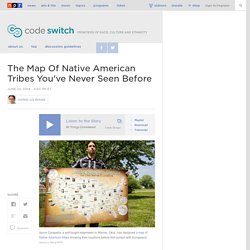
Hansi Lo Wang/NPR hide caption itoggle caption Hansi Lo Wang/NPR Aaron Carapella, a self-taught mapmaker in Warner, Okla., has designed a map of Native American tribes showing their locations before first contact with Europeans. Hansi Lo Wang/NPR Finding an address on a map can be taken for granted in the age of GPS and smartphones. Aaron Carapella, a self-taught mapmaker in Warner, Okla., has pinpointed the locations and original names of hundreds of American Indian nations before their first contact with Europeans. As a teenager, Carapella says he could never get his hands on a continental U.S. map like this, depicting more than 600 tribes — many now forgotten and lost to history. NativeTech: Native American Technology and Art. The theft of Native Americans' land, in one animated map. American society has a remarkably short memory when it comes to past injustices, which is why there are somehow still people who think that Washington's professional football team should continue to be named after "the scalped head of a Native American, sold, like a pelt, for cash.
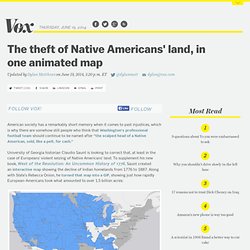
" University of Georgia historian Claudio Saunt is looking to correct that, at least in the case of Europeans' violent seizing of Native Americans' land. To supplement his new book, West of the Revolution: An Uncommon History of 1776, Saunt created an interactive map showing the decline of Indian homelands from 1776 to 1887. Along with Slate's Rebecca Onion, he turned that map into a GIF, showing just how rapidly European-Americans took what amounted to over 1.5 billion acres: Source: Rebecca Onion and Claudio Saunt Blue areas were American Indian homelands, red ones reservations.
Quanah Parker. Quanah Parker (ca. 1845 or 1852 – February 23, 1911) was Comanche/English-American from the Comanche band Noconis ("wanderers" or "travelers"), and emerged as a dominant figure, particularly after the Comanches' final defeat.
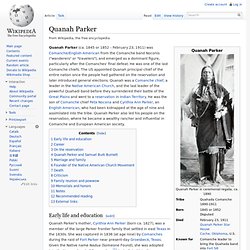
He was one of the last Comanche chiefs. The US appointed Quanah principal chief of the entire nation once the people had gathered on the reservation and later introduced general elections. Native History: The Day Tecumseh’s Prophecy Rocked the World. This Date in Native History: Earthquakes and eclipses of the sun were among the deeds attributed to Tecumseh and his brother, but legends surrounding Tecumseh are as great as the truths, said Shawnee Second Chief Ben Barnes.
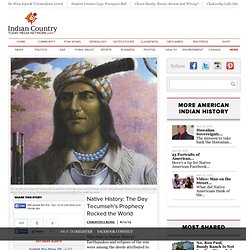
“It is hard to know without proof or specific oral history just exactly what happened” on August 11, 1802 he said. There is evidence that Tecumseh and his brother, Tenskwatawa, were prophets and visionaries who may have changed history had there been a little more help from the British, and more faith from certain tribes. As for help from the Creator, or “Master of Life,” the evidence follows. Tenskwatawa was a victim of the times, with an intense longing for the ways of his childhood and a sense of hopelessness for the future. Lost in alcoholism, Tenskwatawa one day fell into a fire, and lived. Fed up with the ever encroaching, land stealing whites, Tecumseh took his brother’s prophecy and called for all Natives to unite as one people against the whites.
Tecumseh. Tecumseh (/tɛˈkʌmsə/; March 1768 – October 5, 1813) was a Native American leader of the Shawnee and a large tribal confederacy (known as Tecumseh's Confederacy) which opposed the United States during Tecumseh's War and the War of 1812.
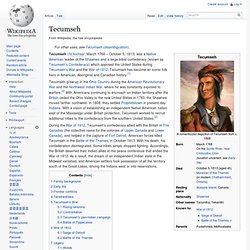
Tecumseh has become an iconic folk hero in American, Aboriginal and Canadian history.[1] Tecumseh grew up in the Ohio Country during the American Revolutionary War and the Northwest Indian War, where he was constantly exposed to warfare.[2] With Americans continuing to encroach on Indian territory after the British ceded the Ohio Valley to the new United States in 1783, the Shawnee moved farther northwest. In 1808, they settled Prophetstown in present-day Indiana. With a vision of establishing an independent Native American nation east of the Mississippi under British protection, Tecumseh worked to recruit additional tribes to the confederacy from the southern United States.[2] Family background[edit] Early life[edit] Frontier conflicts[edit] Trail of Tears. Cultures and peoples of North America. Indigenous Peoples. First North Americans.
Native american indians. American Indians. Canadian Indians. Native. Native American Studies. Native American.